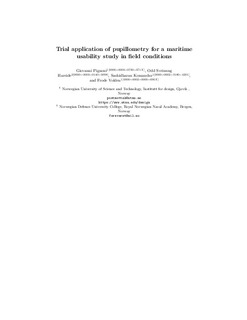| dc.contributor.author | Pignoni, Giovanni | |
| dc.contributor.author | Hareide, Odd Sveinung | |
| dc.contributor.author | Komandur, Sashidharan | |
| dc.contributor.author | Volden, Frode | |
| dc.date.accessioned | 2019-12-17T10:57:39Z | |
| dc.date.available | 2019-12-17T10:57:39Z | |
| dc.date.created | 2019-11-29T10:25:43Z | |
| dc.date.issued | 2019 | |
| dc.identifier.citation | Necesse. 2019, 4 (1), 130-146. | nb_NO |
| dc.identifier.issn | 2464-353X | |
| dc.identifier.uri | http://hdl.handle.net/11250/2633600 | |
| dc.description.abstract | Eye-tracking is a tool employed in usability testing. It is primarily intended as a means for tracking the visual attention patterns of an observer on a continuous basis. Eye-tracking can also capture certain physiological data, such as pupil dilation. Pupil diameter is a validated metric of cognitive workload, meaning the pupil dilates with increasing workload. This research evaluates the fitness, in field conditions, of an eye-tracking based method for accurate measurement of cognitive workload. This implies evaluating the fitness of this tool in changing light conditions such as in coastal navigation. This methodology thus accounts for the effect of light on pupil dilation. This means we are able to account for the effect of only cognitive workload on the pupil dilation even in changing light conditions. This method was applied as a part of an analysis of a navigational exercise involving the navigator and the navigator’s assistant on board a training vessel of the Royal Norwegian Naval Academy. Pupillometry is used alongside egocentric video recordings and Geo-positioning systems (GPS) recordings to allow for multi-faceted evaluation of the activity. Subjective data was recorded as well to evaluate the quality of the eyetracking data. Subjective data was recorded using NASA-TLX self report of mental workload, self-report of mental workload (on three levels) using maps and an expert assessment of the mental workload was obtained for the navigational course. The analysis concluded that pupillometry (through eye-trackers) can have a substantial role in the evaluation of field operations, and provide a good and objective estimate of the perceived workload. The eyetracking technology has substantial limitations, for example sometimes strong infra-red sources of light can impede data collection as such with an eye-tracker, meaning the analysis is labour intensive as it relies on the ability of the operator to filter out low quality data and retain the rest. | nb_NO |
| dc.language.iso | eng | nb_NO |
| dc.publisher | Sjøkrigsskolen | nb_NO |
| dc.relation.uri | http://hdl.handle.net/11250/2630079 | |
| dc.title | Trial application of pupillometry for a maritime usability study in field conditions | nb_NO |
| dc.type | Journal article | nb_NO |
| dc.type | Peer reviewed | nb_NO |
| dc.description.version | acceptedVersion | nb_NO |
| dc.source.pagenumber | 130-146 | nb_NO |
| dc.source.volume | 4 | nb_NO |
| dc.source.journal | Necesse | nb_NO |
| dc.source.issue | 1 | nb_NO |
| dc.identifier.cristin | 1754318 | |
| dc.description.localcode | © 2019. This is the authors' accepted and refereed manuscript to the article. The final authenticated version is available online at: http://hdl.handle.net/11250/2630079 | nb_NO |
| cristin.unitcode | 194,61,45,0 | |
| cristin.unitname | Institutt for design | |
| cristin.ispublished | true | |
| cristin.fulltext | postprint | |
| cristin.qualitycode | 1 | |
